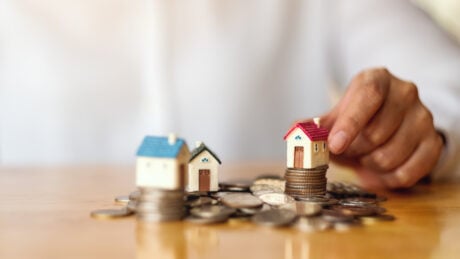If you’re a property owner aged 60 or over, a range of financial options are open to you, including a reverse mortgage.
A reverse mortgage allows you to release the value of your home without having to sell it by trading home equity for cash. No regular repayments are required as the debt will be repaid from the future sale of the property, which means that you can continue to live in your home.
How a reverse mortgage works
A reverse mortgage is less like a conventional home loan and more like a line of credit specifically designed for seniors who have fully paid off their mortgages.
Seniors can use a reverse mortgage for a range of things they may not have the financial means to undertake without such a facility, including home renovations, travel and holidays, ongoing medical expenses and hospital fees. Alternatively, in retirement, reverse mortgages can help satisfy the need for extra cash used in debt consolidation, the restructuring of personal finances, or simply additional income to tackle everyday expenses, such as bills.
Reverse mortgages vs. regular mortgages
An important distinction between a reverse mortgage and a regular home loan is that reverse mortgages don’t require the borrower to make regular repayments while staying in their home.
Instead, interest accrues as the loan compounds over time, which does add to the principal borrowed. The loan is repaid in full when the property is sold by the initial borrower or their deceased estate.
Example of a reverse mortgage loan
You can opt to take your reverse mortgage all at once as a lump sum, a cash reserve, a regular advance (similar to a regular income) or as a combination of the above.
With a cash reserve, for example, if you borrow $20,000 one year and another $10,000 two years later, you are only paying interest on the amount you use. The interest is added to the loan, which means the debt grows but so does the value of the property. Let’s say you borrow $30,000 at 7% per annum, and the annual growth rate of the property is 5%.
Given that you’re only paying interest on $30,000 and the property is valued at $1 million, your net home equity should appreciate at a much higher rate, leaving you ahead in the long run.
Of course, you need to factor in the future of the housing market and interest rate movements, and you can do some easy calculations using a reverse mortgage calculator, which you can find on most lenders’ websites.
How much can you borrow with a reverse mortgage?
There are strict limits on the amounts you can borrow depending on your age. If you’re 60, the most you can borrow is 15% to 20% of your home’s value, then 1% more every year after that.
So, for example, if your home is valued at $1 million, you can borrow between $150,000 and $200,000 in a reverse mortgage. Over time, this figure will grow — by 70, you can access between 25% and 30%, and by 80, it will be 35% – 40%, or between $350,000 and $400,000.
The minimum amount you can borrow will vary depending on your lender but will generally be about $10,000.
Reverse mortgage borrowing limits
These limits are designed to protect your home equity from being fully eroded and to ensure you have enough money left to pay for things such as aged care should you need to.
Additionally, reverse mortgages taken out after 18 September 2012 have negative equity protection, meaning you can’t end up owing the lender more than your home is worth (market value or equity).
Is a reverse mortgage a good idea?
A reverse mortgage may seem too good to be true at first glance — money for a new car and a holiday, and no repayments until the home is sold.
However, despite having some unique quirks, reverse mortgages are still loans from a bank or financial institution that come with associated fees and charges, and ultimately you’ll be required to pay the loan back.
Before taking one on, you should consider how those fees and charges will affect your overall financial situation in the long run.
Reverse mortgage interest rates and fees
You might have spent many years paying off your mortgage, so starting again with a new loan may be daunting. You’ll also more than likely have to pay a higher interest rate than on a standard home loan, so before signing up for a reverse mortgage you should be absolutely sure that you need the money.
Reverse mortgage fees
Then there are the fees, such as loan establishment, home valuation and those associated with ongoing loans. Taking a lump sum will also incur more costs due to the compounding interest payable on a larger upfront amount.
You may be able to make voluntary repayments earlier, or even pay out the entire amount before selling the property, but you’ll need to check what early exit fees may apply.
In the event of your loan running its full course, the amount borrowed plus interest and fees will need to be paid on the sale of the property or by the estate upon the death of the last surviving borrower. In addition, fees and charges on top of interest rates all compound over time.
Reverse mortgage liability
Also, because you’re still the homeowner you’ll be liable for the costs associated with owning the house, such as annual rates or strata fees. At any rate, your lender is required to offer you reverse mortgage projections, which demonstrate the impact of your loan on your finances over time.
As with all financial instruments, reverse mortgages have their own advantages and disadvantages. Before making any final decisions, talk to a trusted professional, such as a financial adviser listed with appropriate qualifications.
DIVE EVEN DEEPER

LVR Meaning: What Is Your Loan-to-Value Ratio?
LVR (loan-to-value ratio) compares the loan amount to the value of a home. A lower LVR means less risk to the lender, which can lead to lower interest rates and a greater chance of approval.

Equity Release: Access Your Home’s Value
Equity release lets you tap into the value of your home.

Home Equity: What It Is and How to Use It
Anyone who has a home likely has some equity built up. While it may not seem like a lot if you’re a new homeowner, equity can grow over time and benefit you since it could increase your net worth.

How to Save for a House Deposit
How you save for a deposit and how long it takes you will be a good indicator not only of how well you manage your finances but how much you can realistically afford in regular mortgage repayments.

